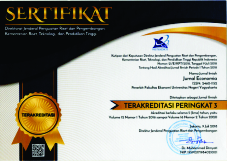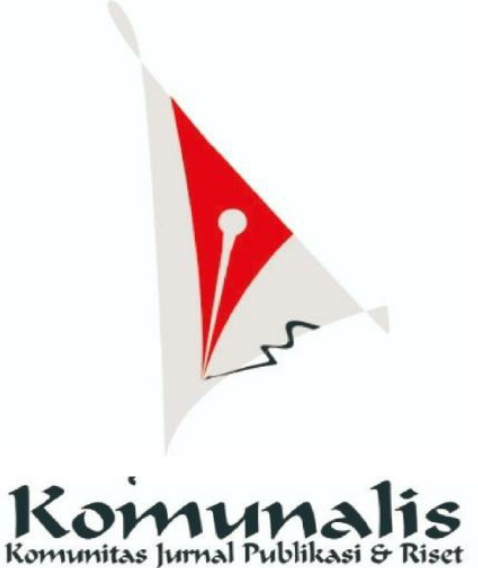The Impact of Digitalization on MSMEs' Financial Performance: The Mediating Role of Dynamic Capability
Downloads
Abstract
The COVID-19 pandemic has negatively affected the 82.9% of MSMEs. They experienced a significant decrease in operating profit due to fixed production costs or increased production costs while the sales declined. Therefore, it requires various strategies to boost the financial performance of MSMEs through digitalization and dynamic capability. The sample consisted of 282 respondents from MSMEs in Central Java which then all primary data were processed using structural equation model analysis. The results of the study showed that digitalization and dynamic capability could enhance the MSMEs' financial performanceand the variable of dynamic capability succeeded in mediating the effect of digitalization on the MSMEs' financial performance.
Keywords:digitalization, dynamic capability, MSMEs' financial performance
Dampak Digitalisasi Terhadap Kinerja Keuangan UMKM: Peran Mediasi Kemampuan Dinamis
Abstrak
Pandemi COVID-19 telah menyebabkan 82,9% UMKM mengalami dampak negatif yakni penurunan profit usahasecara signifikan akibat biaya produksi tetap atau bahkan meningkat sementara penjualan menurun. Oleh karena itu di butuhkan berbagai strategi untuk mendongkrak kinerja keuangan UMKM melalui digitalization dan dynamic capability. Sampel penelitian ini sebanyak 282 responden dari UMKM di Jawa Tengah yang kemudian semua data primer diolah menggunakan analisis Structural Equation Modeling. Hasil penelitian menunjukkan bahwa variabel digitalizationdan dynamic capability mampu meningkatkan kinerja keuangan UMKM serta variabel dynamic capability berhasil memediasi pengaruh digitalization dengan kinerja keuangan UMKM.
Kata kunci:digitalization, dynamic capability, kinerja keuangan UMKM
Downloads
Adeniran, T. V., and Johnston, K. A. (2016). The impacts of ICT utilisation and dynamic capabilities on the competitive advantage of South African SMEs. International Journal of Information Technology and Management, 15(1), 59–89. https://doi.org/10.1504/IJITM.2016.073915
Al-Bakri, A. and Katsioloudes, M. (2015). The factors affecting e-commerce adoption by jordanian SMEs. Management Research Review, 38(7), 726–749.
Alzahrani, J. (2019). The impact of e-commerce adoption on business strategy in Saudi Arabian small and medium enterprises (SMEs). Review of Economics and Political Science, 4(1), 73–88. https://doi.org/10.1108/reps-10-2018-013
Arthur, S., Abanis, T., Eliab, B., and Sumil, N. (2013). Financial Performance in the Selected Microfinance Institutions in Uganda. International Journal of Engineering Research & Technology (IJERT), 2(2), 1–11.
Awa, H. O., Baridam, D. M., and Nwibere, B. M. (2015). Demographic determinants of electronic commerce (EC) adoption by SMEs. Journal of Enterprise Information Management, 28(3), 326. http://search.proquest.com/docview/1664418723?accountid=49672
Barney, J. B., and Wright, P. M. (2010). On Becoming a Strategic Partner : The Role of Human Resource in Gaining Competitive Advantage. Human Resources Management, 37(1), 31–46.
Barreto, I. (2010). Dynamic Capabilities: A review of past research and an agenda for the future. Journal of Management, 36(1), 256–280. https://doi.org/10.1177/0149206309350776
Cho, H., and Tansuhaj, P. S. (2013). Comments on "The parting gift." Thunderbird International Business Review, 49(5), 630–631. https://doi.org/10.1002/tie
Coviello, N., Kano, L., and Liesch, P. W. (2017). Adapting the Uppsala model to a modern world: Macro-context and microfoundations. Journal of International Business Studies, 48(9), 1151–1164. https://doi.org/10.1057/s41267-017-0120-x
Dora, M., Kumar, M., and Gellynck, X. (2016). Determinants and barriers to lean implementation in food-processing SMEs - A multiple case analysis. Production Planning and Control, 27(1), 1–23. https://doi.org/10.1080/09537287.2015.1050477
Drnevich, P.L. and Kriauciunas, A.P. (2010), Clarifying the conditions and limits of the contributions of ordinary and dynamic capabilities to relative firm performance, Strategic Management Journal, 32, 254-279.
ekon.go.id
Fahy, J. (2010). The Resource Based View of the Firm: Some Stumbling Blocks on the Road to Understanding Sustainable Competitive Advantage. Journal of European Industrial Training, 24, 94–104.
Faloye, D. (2014). The adoption of e-commerce in small businesses: an empirical evidence from retail sector in Nigeria. Journal of Business and Retail Management Research, 8(2), 54-65.
Fitriati, T. K., Purwana, D., and Buchdadi, A. D. (2020). Dynamic Capabilities and SMES Performance: The Mediating Effect of Innovation (Study of SMES in Indonesia). Advances in Health Sciences Research, 27(ICoSHEET 2019), 457–464. https://doi.org/10.2991/ahsr.k.200723.115
Gabrielsson, M., and Gabrielsson, P. (2011). Internet-based sales channel strategies of born global firms. International Business Review, 20(1), 88–99. https://doi.org/10.1016/j.ibusrev.2010.05.001
Ghozali, Imam. and Latan, H. (2015). Concepts, Techniques, Applications Using Smart PLS 3.0 for Empirical Research. Diponegoro University Publisher.
Gómez, L. F., and Ballard, D. I. (2013). Communication for the Long Term: Information Allocation and Collective Reflexivity as Dynamic Capabilities. Journal of Business Communication, 50(2), 208–220. https://doi.org/10.1177/0021943612474992
Hamad, H., Elbeltagi, I., and El-Gohary, H. (2018). An empirical investigation of business-tobusiness Egyptian, e-commerce adoption and its impact on SMEs competitive advantage: the case of manufacturing SMEs. Strategic Change, 27(3), 209–229.
Hernández-Linares, R., Kellermanns, F. W., and López-Fernández, M. C. (2020). Dynamic capabilities and SME performance: The moderating effect of market orientation. Journal of Small Business Management, 59(1), 162–195. https://doi.org/10.1111/jsbm.12474
Hill, C. W. L., and Jones., G. R. (2010). Stategic Management : An Integral Approach (3rd ed.). Houghton Mifflin Company.
http://disperindag.jatengprov.go.id
Irfan, M., Wang, M., and Akhtar, N. (2019). Impact of IT capabilities on supply chain capabilities and organizational agility: a dynamic capability view. Operations Management Research, 12, 113–128.
Krell, K., Matook, S., and Rohde, F. (2016). The impact of legitimacy-based motives on IS adoption success: An institutional theory perspective. Information and Management, 53(6), 683–697. https://doi.org/10.1016/j.im.2016.02.006
Laudon, K. C., and Traver, C. G. (2016). E -commerce.
Lee, C. Y., Lee, T. R., and Kao, C.-K. (2015). Study on the Adaptation of Corporate Business Strategy to E-commerce Practice. Advances in Management & Applied Economics, 5(6), 25–43.
Li, L., Lin, J., Turel, O., Liu, P., and Luo, X. (Robert). (2020). The impact of e-commerce capabilities on agricultural firms' performance gains: the mediating role of organizational agility. Industrial Management and Data Systems, 120(7), 1265–1286. https://doi.org/10.1108/IMDS-08-2019-0421
Nelson, R. R., and Winter. (2010). An Evolutionary Theory of Economics Change. Cambridge, MA: Belknap Press of Harvard University Press.
Nick, C., and Bontis. (2012). The Strategic Management of Intellectual Capital and Organizational Knowledge. Oxford University Prees.
Oliva, F. L., Couto, M. H. G., Santos, R. F., and Bresciani, S. (2019). The integration between knowledge management and dynamic capabilities in agile organizations. Management Decision, 57(8), 1960–1979. https://doi.org/10.1108/MD-06-2018-0670
Park, E., and Kim, K. J. (2014). An integrated adoption model of mobile cloud services: Exploration of key determinants and extension of technology acceptance model. Telematics and Informatics, 31(3), 376–385. https://doi.org/10.1016/j.tele.2013.11.008
Pereshybkina, A., Eugenia, M., Conde, C., and Kirner, E. (2017). How will the industry 4.0 transformations affect SMEs in Germany by 2030? Hochschule Furtwangen University.
Picoto, W. N., Bélanger, F., and Palma-Dos-Reis, A. (2014). An organizational perspective on m-business: Usage factors and value determination. European Journal of Information Systems, 23(5), 571–592. https://doi.org/10.1057/ejis.2014.15
Plakoyiannaki, E., Kampouri, A. P., Stavraki, G., andKotzaivazoglou, I. (2015). Marketing Intelligence & Planning Article information : Marketing Intelligence & Planning, 33(3), 238–257.
Popović-Pantić, Sanja., SemenÄenko, DuÅ¡ica., and Vasilić, Nikola. (2020).Digital technologies and the financial performance of female smes in serbia: the mediating role of innovation. Economic Annals, I,X,V(224), 53-81. https://doi.org/10.2298/EKA2024053P
Rachel, H., and Tallott, M. (2016). Baltic Journal of Management Developing dynamic capabilities for learning and internationalization: A case study of diversification in an SME. Journal of Manufacturing Technology Management, 20(5), 547–567.
Raharja, S. J., Tresna, P. W., and Rivani. (2019). "Adoption of Information and Communication Technology on Enhancing Business Performance: Study on Creative Industry SMEs in Bandung City Indonesia. Review of Integrative Business and Economics Research, 8(3), 20–30. https://doi.org/http://buscompress.com/uploads/3/4/9/8/34980536/riber_8-s3_02_t19-122_20-30.pdf.
Rahayu, R., and Day, J. (2017). E-commerce adoption by SMEs in developing countries: evidence from Indonesia. Eurasian Business Review, 7(1), 25–41. https://doi.org/10.1007/s40821-016-0044-6%0A
Ramanathan, R., Ramanathan, U., and Hsiao, H. L. (2012). The impact of e-commerce on Taiwanese SMEs: Marketing and operations effects. International Journal of Production Economics, 140(2), 934–943. https://doi.org/10.1016/j.ijpe.2012.07.017
Rehman, K. U., and Saeed, Z. (2015). Impact of Dynamic Capabilities on Firm Performance: Moderating Role of Organizational Competencies.
Sukkur IBA Journal of Management and Business, 2(2), 20. https://doi.org/10.30537/sijmb.v2i2.92
Rialti, R., Marzi, G., Ciappei, C., and Busso, D. (2019). Big data and dynamic capabilities : a bibliometric analysis and systematic literature review capabilities. https://doi.org/10.1108/MD-07-2018-0821
Slovin, M. J. (1960). Sampling. Simon and Schuster Inc.
Suhendi, C., Nugroho, M., Yahya, H. B., and Zahari, A. S. M. (2020). Dynamic Capabilities for SME's: Ready to Change and Cloud Service Role Toward Digital Business. 115(Insyma), 129–133. https://doi.org/10.2991/aebmr.k.200127.026
Susanty, A., Handoko, A., and Puspitasari, N. B. (2020). Push-pull-mooring framework for e-commerce adoption in small and medium enterprises. Journal of Enterprise Information Management, 33(2), 381–406. https://doi.org/10.1108/JEIM-08-2019-0227
Teece, D. J., Pisano, G., and Shuen, A. (1997). Dynamic capabilities and strategic management. Knowledge and Strategy, 18(7), 509–533. https://doi.org/https://doi.org/10.1142/9789812796929_0004
Tob-Ogu, A., Kumar, N., and Cullen, J. (2018). ICT adoption in road freight transport in Nigeria – A case study of the petroleum downstream sector. Technological Forecasting and Social Change, 131, 240–252. https://doi.org/10.1016/j.techfore.2017.09.021
Wernerfelt, B. (1984). A resource-based view of the firm. Strategic Management Journal, 5(2), 171–180. https://doi.org/10.1002/smj.4250050207
www.bi.go.id
www.bps.go.id
www.lipi.go.id.(2020).
Zhang, P., Zhao, K., and Kumar, R. L. (2016). Impact of IT governance and IT capability on firm Performance. Information Systems Management, 33(4), 357–373.
Zhang, S., Zhao, L., Lu, Y., and Yang, J. (2016). Do you get tired of socializing? an empirical explanation of discontinuous usage behaviour in social network services. Information and Management, 53(7), 904–914.















